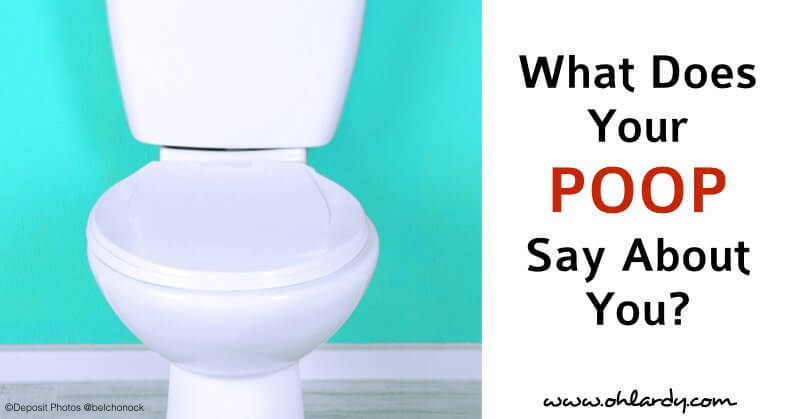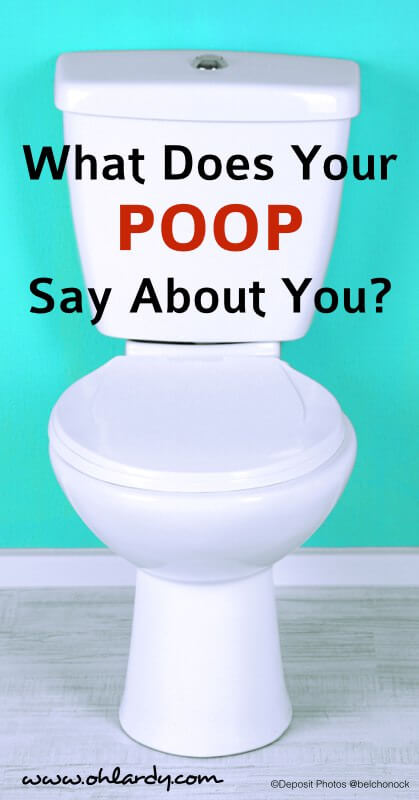The Rules on Stools: What is Your Poop Telling You?
Oh Lardy! is a participant in the Amazon Services LLC Associates Program, an affiliate advertising program designed to provide a means for us to earn fees by linking to Amazon.com and affiliated sites.

I have always been intrigued by poop and what it says about your health and wellness. Today, my friend, Elyse Wagner, a holistic nutritionist, breaks it all down about what your poop is telling you!! Elyse is a Holistic Nutritionist and Positive Psychology Coach. Oh Lardy is thrilled to have her join us today and share her knowledge on poop and your health! Be sure to check out her video from her ETV series!
What is your poop telling you?
I'm always intrigued by a “NUMBER TWO”.
Yep – you guessed it! I'm talking about POO!
For example, I really do enjoy reading and researching what is really going on with our poop and how our diet affects our bowels. It is true, our trusty poo does give us A LOT of information about our digestion and what is going on inside of us.
So today, I thought I'd get a little down and dirty and share with you the vital scoop on poop!
Poop tells us a lot. The hue, the flow, the form and the feeling generated by a poo tells a story about what you've put in your mouth and down your digestive tract — more than what's right below the toilet waterline. So sit back and relax because it's time for a mini session of what your is poo telling you! Keep reading and watching for more scoop.
The Rules On Stools
So let's focus on the hue of poo:
Poop comes in many colors.
Brown:
This usual color is formed from stercobilin or the little bacteria in our colon that digests bile from our gallbladder. Now, the color of brown will vary each day due to the different types of food, liquid and medications you take in. If you do have different changes in color for longer periods of time, it can be a sign of an underlying gastrointestinal disorder that you'll want to get checked out by your health-care professional.
White:
Now, if you're not consuming barium which is a chalk like substance (that you get before an X-ray or CT scan) than you may have to look further. White stool can be a sign of a bile duct blockage or other types of liver disease. It is rare and develops slowly over days to weeks. What you need to know is that white is not right when we're talking about poo so a doctor visit is a must!
Black:
Black poo is a sign that you're taking in foods high in iron or iron supplements or bismuth compounds i.e: Pepto-Bismol. It could be caused by blood that is higher up in the digestive tract.
Green:
The mean, green poops are caused by one of two things. What you're eating or by an infection. Green leafy veggies such as spinach, kale and collards are one of the culprits of green poo. Infections in the bowels can also cause green poop and often pops up after a course of antibiotics and treatment for the type of bug called Clostridium difficle.
Red:
Having red poo can signify you've just had yourself a serving of beets or there is blood in your lower digestive tract and you need to seek an doctor as soon as possible. Let's just hope the pink reddish color is because you're eating lots of beets.
Yellow:
Yellow poo can mean fat in the stool which usually occurs because your body is not digesting fat properly. This produces a yellow, glistening, floating stool indicating an issue with the small intestine, pancreas or liver.
So what is your poop telling you?
I challenge you to take a peek–or just glance at your poop the next time you have a bowel movement, and ask yourself what color it is and what the form is. What I love about this exercise is that as you make changes with what's going in (i.e: with your food, liquid, exercise, stress), you'll notice changes to what is going out.
My rule of thumb is, if it's not the norm for more than a couple of days , you may want to have it checked out by your doc! This is how I found out I was living with Celiac disease.
Flow and form of poo:
For a mini chart of poops, you can download your very own Stool Chart. And if you're really interested in being in tune with your poop – stick it up in your bathroom to give both the chart and your poop a look-see the next time you sit down for a ‘second session.'
Comment from Tamara: Ideally you want your stools to be somewhere between 3 and 4. Stages 1, 2, 5, 6 and 7 can signal problems!
In the comments section, I'd love for you to share your rules on stools!
Hope to see you there!
Thank you so much for reading, watching and commenting!
Xoxo,
Elyse
About Elyse Wagner:

Pin It!



this is quite the subject eh? but hey!! we all have to do it!!
so what do you consider a normal poo?
thanks for talking about a very important part of life.
Yes it is!! And you’re welcome! It is such an important part of our daily lives that kind of gets skimmed over but we need to look at it and sometimes closely.
A “normal” poop is going to look inbetween a 3 + 4. You want it to well, look like a “log.” Not too bumpy and hard to pass, just comes out easy and is smooth looking. The color should be brown.
Thanks for the comment and question! : )
xoxo,
E
I find this helpful and always aware of the changes, but don’t always know what causes them. Like the other comment, the chart is helpful, just which type is most normal to be on the look for? Thanks
Awesome question Sherri!
Look for something in-between 3-4. When you start getting into the nuggets more so towards the 1 end of the spectrum or towards a 6 or 7, your body is telling you – “hey – something is not agreeing with me.” If you’re towards the pebbles/stones or nuggets that signifies constipation – usually due to a lack of water or too much fiber intake. If you’re more towards the liquid or watery poop, that could tell you there is some issues with digesting your food, possible parasite/virus, IBS or issues with the colon and/or medicines that may cause an upset leading to diarrhea.
I printed out the stool form scale but what does type 1 through type 7 mean.
Hi Heather!
Awesome question!
Type 1 and 2 is going to denote consipation – meaning something in your lifestyle (eating and or emotional health) could be causing upset GI. A great place to start is to look at your fluid intake vs. your fiber intake. Make sure you’re getting enough water throughout the day to keep things moving 🙂
Type 3 and 4 is more towards “normal” meaning things are moving smoothly.
and 5 – 7 is moving more towards diarrhea. This means that there could be a few things going on that you will want to look into further with a trusted healthcare professional. It could be due to a parasite/virus or simply because your gut motility has been reduced. Our poop contains what is left after our digestive system absorbs nutrients and fluids from what your food and drink. If your body does not absorb the fluids, or if your digestive system produces extra fluids, stools will be loose and watery.
Hope that helps! : )
Elyse
Great info but I wonder what it means if your poo floats as opposed to sinking in the water?
One thing I also learned to watch for from my cousin, who has colon cancer, is the overall size of the stool “log.” If you notice that the circumference (not the consistency of the stool)is getting smaller and thinner you should be seen. In his case it was the only sign of colon cancer he had.
I don’t know if it’s just me or if everyone else experiencing problems with your site.
It looks like some of the text within your content are running off the screen. Can someone else please provide feedback and let
me know if this is happening to them as well? This might be a issue with
my browser because I’ve had this happen before.
Many thanks
I can’t read the chart cuz it is blurry. Any body else have that problem!
Click on the chart and it will open up by itself and is very clear to read.